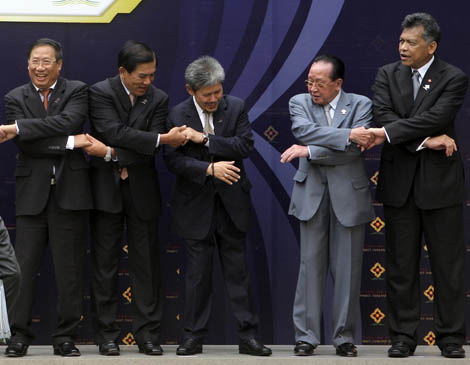Just How "Central" is ASEAN, Anyway?
More on:

The Australian National University’s East Asia Forum has reprinted a fascinating speech by the talented Surin Pitsuwan, secretary-general of the Association of Southeast Asian Nations (ASEAN).
After reflecting on how ASEAN is helping the world emerge from the present financial crisis, Surin argues that ASEAN is “now more integrated, and resilient, than many had thought.”
But for the sake of argument, I think it’s worth picking apart that statement on three dimensions.
Here’s the core of Surin’s argument:
“Over the past 40 years we have developed a ‘workable diplomatic sculpture’ called ASEAN. The experience of other regional groupings shows that they all have a strong core. The European Union has coal and steel cooperation. The North American Free Trade Area is centred around the United States—the strongest economy in the world. [But] ASEAN is designed in the reverse. ASEAN has a rather loose core but draws on connectivity and dialogue to generate real partnership.”
And here’s Surin’s punchline: “We are not perfect but we can provide centrality and leadership to shape the regional landscape.”
With the Obama Administration reviewing the U.S. posture, both toward Asian regional organizations and toward Southeast Asia more generally, Surin’s argument raises three important—but tough—issues:
(1) Is ASEAN, with its “rather loose core,” quite so integrated?
(2) Can ASEAN provide “centrality and leadership” to Asian regionalism?
(3) And how many, and what kind of, eggs should the U.S. put in the ASEAN basket, anyway? An alternative would be to pursue a largely bilateral approach, or at least to diversify the U.S. portfolio in Southeast Asia.
I won’t settle these issues here, but I addressed them (hopefully, in provocative way...) in a recent Council on Foreign Relations Special Report that I co-authored with Bob Manning, The United States in the New Asia.
First, it’s worth noting that ASEAN integration is a work in progress. We shouldn’t ignore the successes. Forty years of commitment have altered the fundamental dynamics between Southeast Asian states. ASEAN has successfully leveraged meetings at all levels to foster a sense of common interest, reinforced by personal acquaintance with counterparts in other ASEAN capitals. (And it has had some notable successes—for example, in the 1991 Cambodian peace settlement).
But disparities of capacity and conflicting objectives make it difficult to address functional challenges. Expansion of its membership to Indochina and Myanmar and the weakness of ASEAN’s alphabetically rotating chairmanship have created structural limitations to ASEAN effectiveness. ASEAN’s founding members, understandably, wanted all ten Southeast Asian countries joined as a cohesive force to help balance China. But their timing was poor: Myanmar could not be assimilated to ASEAN ways and—unlike Vietnam—Cambodia and Laos carry little weight. A “wise persons” commission asked to advise on the creation of an ASEAN charter recommended replacing consensus with majority decision-making, but the adopted charter has fallen short of this goal.
Second, I’m increasingly skeptical that ASEAN will be quite so central to the future of East Asian regionalism.
This is a pregnant subject, as Australian Prime Minister Kevin Rudd, who advocated a new, non-ASEAN-centric architecture, has discovered. Indeed, as Graeme Dobell sharply put it over at the Lowy Institute’s Interpreter blog, “Rudd to ASEAN: You Win.”
Still, the United States should take heed because China, Japan, and South Korea, each in its own way, are posing their own questions and challenges.
One of the ironies of modern Asia is that Southeast Asians built most regional groups, even though the region’s economic, military, and diplomatic power resides overwhelmingly in Northeast Asia. There is now a serious mismatch: the part of East Asia with so much less economic, technological, and military capacity has become the principal architect of nearly every recent effort to pool Asian power and capacity.
That’s important because Beijing, Tokyo, and Seoul seem openly skeptical of this state of affairs. And that partly explains their growing emphasis on their own mechanisms, including dialogues, a prospective trade agreement, and especially a “Plus Three” process that began in Bali in October 2003.
Third, then, while the United States would be foolish to pay ASEAN no heed, American policy shouldn’t conflate “ASEAN” with “Southeast Asia.” Indeed, for all the rhetorical hype from the administration about how “the U.S. is back” in its relations with ASEAN, the administration’s actions make clear that it has decided—correctly—that a little portfolio diversification is in order.
The U.S. now works with ASEAN through an array of mechanisms, including the ASEAN-U.S. Cooperation Plan announced in 2002; the ASEAN-U.S. Technical Assistance and Training Facility established inside the ASEAN secretariat in 2004; the ASEAN-U.S. Enhanced Partnership agreement signed in 2005; the Enhanced Partnership Plan of Action signed in 2006; the ASEAN-U.S. Trade and Investment Framework Agreement also established in 2006; and under the rubric of the Treaty of Amity and Cooperation, which the United States joined after Obama took office in 2009. In September 2008 the U.S. became the first ASEAN dialogue partner to appoint an ambassador to ASEAN, an initiative spearheaded by Senator Richard Lugar. And President Obama has also taken the important step of inaugurating a U.S.-ASEAN leaders meeting.
But Thailand and the Philippines have become less coherent polities, less effective both inside and outside the ASEAN context. Meanwhile, Indonesia, Singapore, and Vietnam have become more prominent and economically dynamic, with robust bilateral ties to the United States. As a vibrant new democracy and a member of the G20, Indonesia has rightly garnered special attention from the administration. And U.S.-Malaysia relations have improved on the basis of trade, counterterrorism cooperation, and military exchanges.
Given the considerable gap in military, economic, and diplomatic power between Northeast and Southeast Asia, it’s increasingly clear that there will always be serious limitations to ASEAN-centric multilateralism.
More on:
 Online Store
Online Store
